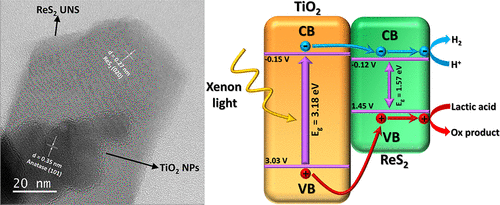当前位置:
X-MOL 学术
›
ACS Mater. Lett.
›
论文详情
Our official English website, www.x-mol.net, welcomes your feedback! (Note: you will need to create a separate account there.)
Atomic-Level Insights into the Edge Active ReS2 Ultrathin Nanosheets for High-Efficiency Light-to-Hydrogen Conversion
ACS Materials Letters ( IF 11.4 ) Pub Date : 2020-10-12 , DOI: 10.1021/acsmaterialslett.0c00205 Jingrun Ran 1 , Hongping Zhang 2 , Jiangtao Qu 3 , Jieqiong Shan 1 , Shuangming Chen 4 , Fan Yang 5 , Rongkun Zheng 3 , Julie Cairney 3 , Li Song 4 , Liqiang Jing 5 , Shi-Zhang Qiao 1
ACS Materials Letters ( IF 11.4 ) Pub Date : 2020-10-12 , DOI: 10.1021/acsmaterialslett.0c00205 Jingrun Ran 1 , Hongping Zhang 2 , Jiangtao Qu 3 , Jieqiong Shan 1 , Shuangming Chen 4 , Fan Yang 5 , Rongkun Zheng 3 , Julie Cairney 3 , Li Song 4 , Liqiang Jing 5 , Shi-Zhang Qiao 1
Affiliation

|
The development of highly active and reliable photocatalysts for solar hydrogen (H2) production requires the thorough and in-depth understanding of the atomic-level structure/composition-performance relationship in photocatalysts. In this contribution, we for the first time develop a new and simple technique to prepare the ReS2 ultrathin nanosheets (UNSs) with massive atomic-level edge sites. The atomic-resolution scanning transmission electron microscopy integrated with density functional theory (DFT) based computations predicts that these atomic-level edge sites can efficiently boost H2 evolution. Hence, the as-synthesized ReS2 UNSs are coupled with the three most extensively explored photocatalysts, i.e., TiO2, CdS, and melon, for apparently enhanced photocatalytic H2 production. Particularly, the TiO2 decorated ReS2 UNS exhibits a significantly improved photocatalytic H2-production rate of 1037 μmol h–1 g–1, 129.6 times larger than that of bare TiO2. Moreover, the TiO2/ReS2 composites were investigated by both DFT-based calculations and state-of-art characterizations, e.g., synchrotron radiation based X-ray absorption near edge structure and transient-state surface photovoltage/photoluminescence spectroscopy. The results indicate that the abundant atomic-level edge active sites of ReS2 UNSs greatly advance the H2 evolution while their relatively intact basal planes rapidly transfer the electrons to those edge active sites. Besides, the notable electronic coupling between ReS2 and TiO2 remarkably accelerates the dissociation/migration of photo-induced electron-hole pairs. Our work not only affords the atomic-level insights into the edge active sites of ReS2 UNSs in the photocatalysis field but also pave new avenues to the engineering of atomic-level reactive sites on two-dimensional materials for solar energy conversion.
中文翻译:

边缘活性ReS 2超薄纳米片的原子级洞察力,可实现高效的光氢转化
开发用于太阳能氢(H 2)的高活性和可靠的光催化剂需要对光催化剂的原子级结构/组成-性能关系进行透彻和深入的了解。在这项贡献中,我们首次开发了一种新的简单技术来制备具有大量原子级边缘位点的ReS 2超薄纳米片(UNS)。结合基于密度泛函理论(DFT)的计算的原子分辨率扫描透射电子显微镜可以预测,这些原子级边缘位点可以有效地促进H 2的演化。因此,合成后的ReS 2 UNS与三种最广泛研究的光催化剂,即,TiO 2,CdS和甜瓜,明显增强了光催化H 2的产生。尤其是,用TiO 2装饰的ReS 2 UNS的光催化H 2产生速率显着提高,为1037μmolh –1 g –1,是裸TiO 2的129.6倍。此外,在TiO 2 / RES 2层复合材料是由基于DFT的计算和状态的最先进的表征,无论调查例如,基于同步辐射的X射线在边缘结构附近的吸收以及瞬态表面光电压/光致发光光谱。结果表明,ReS 2 UNS的大量原子级边缘活性位点大大促进了H 2的演化,而它们相对完整的基面则将电子迅速转移到这些边缘活性位点。此外,ReS 2和TiO 2之间显着的电子耦合显着加速了光致电子-空穴对的解离/迁移。我们的工作不仅提供了ReS 2边缘活跃站点的原子级洞察力 UNS在光催化领域的应用,也为在二维材料上进行原子级反应位的工程化为太阳能转化开辟了新途径。
更新日期:2020-11-02
中文翻译:

边缘活性ReS 2超薄纳米片的原子级洞察力,可实现高效的光氢转化
开发用于太阳能氢(H 2)的高活性和可靠的光催化剂需要对光催化剂的原子级结构/组成-性能关系进行透彻和深入的了解。在这项贡献中,我们首次开发了一种新的简单技术来制备具有大量原子级边缘位点的ReS 2超薄纳米片(UNS)。结合基于密度泛函理论(DFT)的计算的原子分辨率扫描透射电子显微镜可以预测,这些原子级边缘位点可以有效地促进H 2的演化。因此,合成后的ReS 2 UNS与三种最广泛研究的光催化剂,即,TiO 2,CdS和甜瓜,明显增强了光催化H 2的产生。尤其是,用TiO 2装饰的ReS 2 UNS的光催化H 2产生速率显着提高,为1037μmolh –1 g –1,是裸TiO 2的129.6倍。此外,在TiO 2 / RES 2层复合材料是由基于DFT的计算和状态的最先进的表征,无论调查例如,基于同步辐射的X射线在边缘结构附近的吸收以及瞬态表面光电压/光致发光光谱。结果表明,ReS 2 UNS的大量原子级边缘活性位点大大促进了H 2的演化,而它们相对完整的基面则将电子迅速转移到这些边缘活性位点。此外,ReS 2和TiO 2之间显着的电子耦合显着加速了光致电子-空穴对的解离/迁移。我们的工作不仅提供了ReS 2边缘活跃站点的原子级洞察力 UNS在光催化领域的应用,也为在二维材料上进行原子级反应位的工程化为太阳能转化开辟了新途径。


























 京公网安备 11010802027423号
京公网安备 11010802027423号